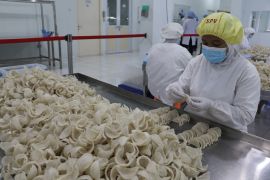Beijing, (ANTARA News) - The United States and China escalated their acrimonious trade war on Thursday, implementing punitive 25 percent tariffs on $16 billion worth of each other`s goods, even as mid-level officials from both sides resumed talks in Washington.
The world`s two largest economies have now slapped tit-for-tat tariffs on a combined $100 billion of products since early July, with more in the pipeline, adding to risks to global
economic growth.
China`s Commerce Ministry said Washington was "remaining obstinate" by implementing the latest tariffs, which kicked-in on both sides as scheduled at 12:01 p.m. in Beijing (0401 GMT).
"China resolutely opposes this, and will continue to take necessary countermeasures," it said in a brief statement.
"At the same time, to safeguard free trade and multilateral systems, and defend its own lawful interests, China will file suit regarding these tariff measures under the WTO dispute
resolution mechanism," it said, as reported by Reuters.
President Donald Trump has threatened to put duties on almost all of the more than $500 billion of Chinese goods exported to the United States annually unless Beijing agrees to
sweeping changes to its intellectual property practices, industrial subsidy programmes and tariff structures, and buys more U.S. goods.
That figure would be far more than China imports from the United States, raising concerns that Beijing could consider other forms of retaliation, such as making life more difficult for American firms in China or allowing its yuan currency to weaken further to support its exporters.
"We have more bullets"
Trump administration officials have been divided over how hard to press Beijing, but the White House appears to believe it is winning the trade war as China`s economy slows and its stock
markets tumble.
"They`re not going to give that up easily. Naturally they`ll retaliate a little bit," U.S. Commerce Secretary Wilbur Ross said on CNBC on Wednesday at a Century Aluminum smelter
in Hawesville, Kentucky, which is restarting idled production lines due to Trump`s aluminium tariffs.
"But at the end of the day, we have many more bullets than they do. They know it. We have a much stronger economy than they have, they know that too," Ross said.
Economists reckon that every $100 billion of imports hit by tariffs would reduce global trade by around 0.5 percent.
They have assumed a direct impact on China`s economic growth in 2018 of 0.1-0.3 percentage points, and somewhat less for the United States, but the impact will be bigger next year, along
with collateral damage for other countries and companies tied into China`s global supply chains. Hard line rattles Beijing
The tariffs took effect amid two days of talks in Washington between mid-level officials from both sides, the first formal negotiations since U.S. Commerce Secretary met with Chinese economic adviser Liu He in Beijing in June.
Business groups expressed hope that the meeting would mark the start of serious negotiations over Chinese trade and economic policy changes demanded by Trump.
However, Trump on Monday told Reuters in an interview that he did not "anticipate much" from the talks led by U.S. Treasury Under Secretary David Malpass and Chinese Commerce Vice Minister
Wang Shouwen.
Trump`s hard line has rattled Beijing and spurred rare criticism within the highest levels of China`s ruling Communist Party over its handling of the trade war, sources have said.
Beijing has denied U.S. allegations that it systematically forces the unfair transfer of U.S. technology and has said that it adheres to World Trade Organization rules.
Don't be greedy
The official Xinhua news agency said in a commentary on Thursday that China approached the latest round of talks in good faith, but that Washington remains vague about what it wants.
"As U.S. President Donald Trump said in his book on making deals, `the point is that you can`t be too greedy.` The two sides would hence be advisable to define their top concerns in this round of talks and outline a roadmap, in a bid to find a way out of the current impasse and towards the final settlement of the issues."
Washington`s latest tariffs apply to 279 product categories including semiconductors, plastics, chemicals and railway equipment that the Office of the U.S. Trade Representative has said benefit from Beijing`s "Made in China 2025" industrial plan to make China competitive in high-tech industries.
China`s list of 333 U.S. product categories hit with duties includes coal, copper scrap, fuel, steel products, buses and medical equipment.
Though it is too early for the trade battle to show up in much economic data as yet, tariffs are beginning to increase costs for consumers and businesses on both sides of the Pacific, forcing companies to adjust their supply chains and pricing, with some U.S. firms looking to decrease their reliance on China.
One executive at a major U.S. manufacturer in China told Reuters the uncertainty about the duration of the trade conflict was more damaging than the tariffs themselves because it made business planning difficult.
If the tariffs are in place for long, there will come a point at which the company would begin moving some sourcing and production out of China, a process that would be irreversible for several years once set in motion, the executive said, declining to be identified due to the sensitivity of the matter.
Editing by: Tia Mutiasari / Boyke S.
Reporter: Antara
Editor: Chaidar Abdullah
Copyright © ANTARA 2018











